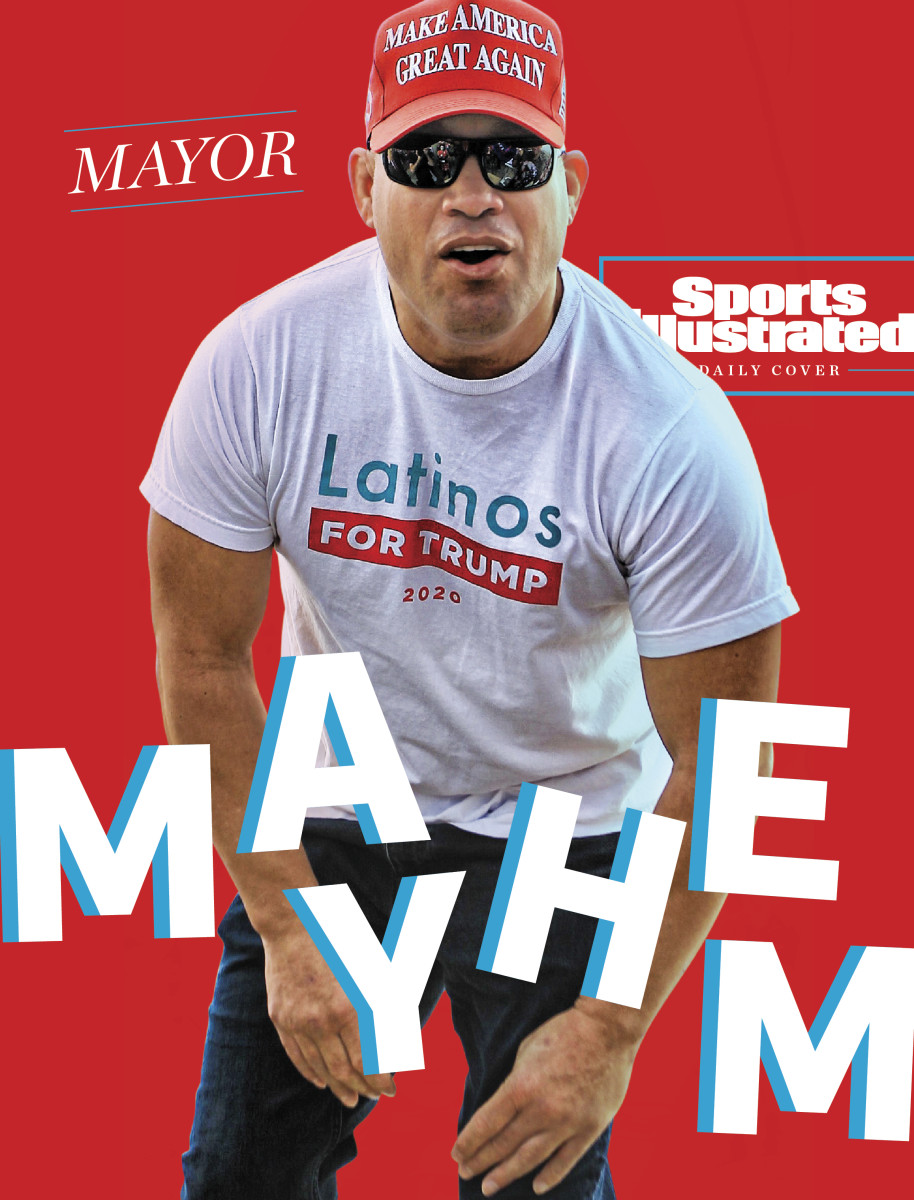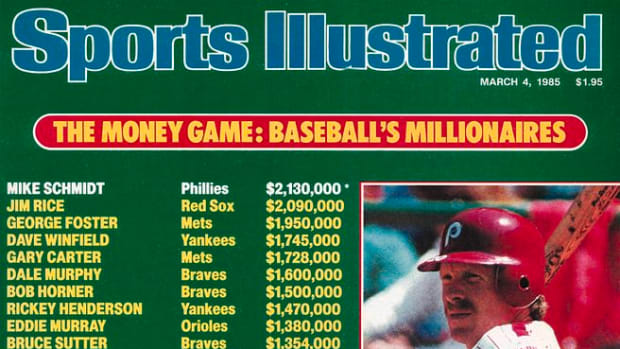SI:AM | Five Guys at the NFL Combine You Need to Know About
Good morning, I’m Dan Gartland. I’m glad there isn’t a sportswriters combine.
If you're reading this on SI.com, you can sign up to get this free newsletter in your inbox each weekday at SI.com/newsletters.
Keep an eye on these draft prospects
Conor Orr convincingly wrote a couple of weeks ago that very few draft prospects should ever attend the NFL combine. On the one hand, he’s right that working out at the combine has a much bigger chance of hurting a top prospect’s draft stock than it does of improving it. On the other hand, it’s fun to watch the guys run fast.
The first slate of on-field workouts took place last night (in prime time because the NFL loves trying to turn mundane football-adjacent events into televised spectacles), with the quarterbacks, wide receivers and tight ends taking the field. Running backs and offensive linemen are up later today, followed by defensive linemen and linebackers tomorrow and defensive backs, kickers and punters on Sunday.
You can check out Kevin Hanson’s list of the top 100 prospects in the draft if you want well-informed analysis of the biggest prospects, but I want to focus on these five guys. They aren’t necessarily the five best in Indianapolis, just five dudes who I find interesting.
Evan Neal, OT, Alabama (No. 4 on Hanson’s big board)
It makes sense that the Jaguars would want to draft an offensive tackle with the No. 1 pick to protect last year’s No. 1 pick Trevor Lawrence. That could end up being North Carolina State’s Ikem Ekwonu (No. 5 on Hanson’s list), Mississippi State’s Charles Cross (No. 7) or Neal (No. 4).
It’ll be interesting to see how each player’s stock evolves in the eight weeks before the draft, but right now I’m obsessed with Neal. He’s 6'7" and weighed in at the combine at 337 pounds. And somehow, he looks… thin? When you see him standing at the podium, he looks like a safety.
Neal weighed 400 pounds in high school and played at about 350 at Alabama. As Richard Johnson writes, size isn’t always a benefit for NFL linemen trying to stop smaller, more agile pass rushers. But as this video of Neal doing box jumps shows, his athleticism is off the charts. That contrast makes him a fascinating draft prospect.
Kenny Pickett, QB, Pittsburgh (No. 22)
Pickett is Hanson’s top quarterback. Throwing 42 touchdowns as a fifth-year senior (after not having thrown more than 13 in any previous season) vaulted him up draft boards. But he was dealt a serious blow yesterday when his hands measured a measly 8.5 inches.
Hand size is one of those things that gets overanalyzed at the combine. (To Orr’s point about the combine hurting more than it helps, would anybody be talking about Pickett’s hands if he hadn’t gone to Indy?) When Joe Burrow’s hands measured at 9 inches in 2020, he tweeted, “Considering retirement after I was informed the football will be slipping out of my tiny hands. Please keep me in your thoughts.”
Indeed, Pickett’s hands would be the smallest of any quarterback currently in the NFL, but the correlation between hand size and fumble risk is weak. Cincinnati quarterback Desmond Ridder, whose hands measured 10" at the combine, fumbled 36 times in college. Pickett had 26.
Kyle Hamilton, S, Notre Dame (No. 3)
Hamilton won’t work out until the final day of the combine, but you won’t want to miss it. After a stellar three-year career with the Irish, he has a chance to be the highest drafted safety in more than 30 years.
Since Eric Turner went No. 2 to the Browns in 1991, only two safeties have been selected in the top five of the NFL draft: Sean Taylor (No. 5 in 2004) and Eric Berry (No. 5 in ’10). Hanson had Hamilton going fourth to the Jets in his latest mock draft.
Malik Willis, QB, Liberty (No. 35)
Without a standout quarterback in this year’s class, it isn’t out of the question that Willis ends up being the first QB off the board.
He burst on the scene after transferring to Liberty following two seasons at Auburn. As a redshirt junior last season, he passed for 2,857 yards with 27 touchdowns and 12 interceptions.
“No quarterback in this class has as much upside as Willis, but his floor is probably the lowest of the top QBs as well,” Hanson writes.
Willis has a strong arm and is the best runner of any QB in the class (he ran for 1,822 yards in his two seasons at Liberty). He’s also drawing praise after he was spotted in Indianapolis helping out a person in need.
Chris Olave, WR, Ohio State (No. 24)
Olave was a stud for the Buckeyes, and there’s no reason to think his game won’t translate to the next level. He briefly set the world on fire last night when he was unofficially clocked at 4.26 seconds in the 40-yard dash, but his official time was 4.39—still very impressive and good for eighth among receivers. Hanson had him as a late first-round pick in last month’s mock draft, but we’ll see if his combine performance moves him up teams’ boards.
The best of Sports Illustrated

After a long career in the UFC, Tito Ortiz, somewhat surprisingly, turned his attention to politics. Jon Wertheim and Josh Gross detailed how in 2020 he became a conspiracy monger and mayor pro tempore of his hometown, Huntington Beach, Calif., in today’s Daily Cover.
Tomorrow is Coach K’s “senior day,” Pat Forde writes. … It looked for a minute like we were going to see a bunch of high-profile quarterbacks swap teams this offseason, but Orr explains why that’s no longer the case. … Jonathan Wilson recaps Roman Abramovich’s wildly successful two-decade run as owner of Chelsea, which is about to come to an end. … Ross Dellenger checks in on college football’s much-derided, but verifiably effective, targeting rule. With the Beijing Winter Paralympics beginning today, read Michael Rosenberg’s profile of Andrew Kurka, the reigning downhill champ.
Around the Sports World
The NFL and NFLPA have agreed to suspend all COVID-19 protocols for next season. … The Bengals’ special teams coach says he wasn’t happy with kicker Evan McPherson watching the Super Bowl halftime show instead of being in the locker room. … Robert Griffin III’s planned “explosive tell-all” book is no longer being released. … Iowa Gov. Kim Reynolds signed legislation yesterday that banned transgender girls from competing in women’s sports in schools and colleges.
The top 5...
… things I saw last night
5. Lightning coach Jon Cooper becoming the first coach since 2018 to be ejected for “abuse of an official”
4. Kevin Durant scoring 31 points in his return after missing 21 games
3. Reggie Jackson messing with Russell Westbrook
2. Charles Barkley refusing to say the Lakers’ name after another disappointing loss
1. Ja Morant’s latest highlight dunk
SIQ
On March 4, 1990, Loyola Marymount star Hank Gathers collapsed on the court during a West Coast Conference tournament game. Less than two hours later, he was pronounced dead. He was 23.
The conference canceled the rest of the tournament and selected Loyola, the regular season champion, to represent it in the NCAA tournament. During the tournament, how did Gathers’s teammate Bo Kimble choose to honor his late friend?
Check Monday's newsletter for the answer.
Yesterday’s SIQ: On March 3, 1983, an NFL quarterback was admitted to the hospital with a pseudonym to protect his privacy. Years later, a quarterback whose real name was the same as the older player’s fake name went on to have success in the NFL. Can you name both players?
Answer: Terry Bradshaw and Tom Brady. I wrote a post about this after the story went viral last year in the wake of Brady’s last Super Bowl win. Bradshaw was admitted to a hospital in his hometown of Shreveport, La., for surgery to address an elbow injury that had nagged him since training camp the year before. In order to keep fans and reporters away from the hospital, Bradshaw was given an alias: Thomas Brady. It wasn’t his idea, but it’s still amazing that whoever came up with the fake name picked one that would belong to another NFL legend.
From the Vault: March 4, 1985

Against the backdrop of the current MLB lockout, this SI cover from nearly 40 years ago is particularly interesting. In 1985, every baseball player making at least $1 million (36 of them) could be listed on the cover of the magazine in not-so-fine print. Phillies slugger Mike Schmidt led the way with a guaranteed salary of $2.13 million. That’s the equivalent of $5.6 million today, or $31 million less than what Gerrit Cole makes per year.
Ivan Maisel’s story examines baseball’s salary arbitration system, which had been instituted 11 years earlier, and how it led to a sharp increase in player earnings.
“The owners won seven of the 13 [arbitration] cases this year and have a 102–86 record since arbitration began in 1974. But in the same period the average annual salary has risen from $40,839 to $329,408. And the highest individual salary has grown from Dick Allen's $225,000 to Mike Schmidt's $2,130,000.”
Salaries have continued to grow in the decades since. Nolan Ryan was the first player to earn an average of $1 million per year when he signed with the Astros in November 1979. Roger Clemens was the first to pass $5 million in ’91. Five years later, Albert Belle was the first to eclipse $10 million, and just four years after that, signed with the Rangers for an average of $25.2 million per year. Cole now holds the record at $36 million per year. There’s plenty of money in the game today—much more than there was in ’85—it’s just a matter of distributing it equitably.
Check out more of SI's archives and historic images at vault.si.com.
